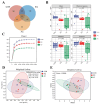Comparative Study of an Antioxidant Compound and Ethoxyquin on Feed Oxidative Stability and on Performance, Antioxidant Capacity, and Intestinal Health in Starter Broiler Chickens
- PMID: 39456482
- PMCID: PMC11505240
- DOI: 10.3390/antiox13101229
Comparative Study of an Antioxidant Compound and Ethoxyquin on Feed Oxidative Stability and on Performance, Antioxidant Capacity, and Intestinal Health in Starter Broiler Chickens
Abstract
Concerns over the safety of ethoxyquin (EQ) highlight the need for safer, more effective feed antioxidants. This study investigated a healthier antioxidant compound (AC) as a potential alternative to EQ in broilers. A total of 351 one-day-old Arbor Acres Plus male broilers were randomly assigned to three treatments for 21 days: control (CON), EQ group (200 g/ton EQ at 60% purity), and AC group (200 g/ton AC containing 18% butylated hydroxytoluene, 3% citric acid, and 1% tertiary butylhydroquinone). AC supplementation reduced the acid value, peroxide value, and malondialdehyde content in stored feed, decreased feed intake and the feed conversion ratio without affecting body weight gain, and enhanced antioxidant capacity (liver total antioxidant capacity and superoxide dismutase; intestinal catalase and glutathione peroxidase 7). It improved intestinal morphology and decreased barrier permeability (lower diamine oxidase and D-lactate), potentially by promoting ZO-1, Occludin, and Mucin2 expression. The AC also upregulated NF-κB p50 and its inhibitor (NF-κB p105), enhancing immune regulation. Additionally, the AC tended to increase beneficial gut microbiota, including Lactobacillus, and reduced Bacteroides, Corprococcus, and Anaeroplasma. Compared to EQ, the AC further enhanced feed oxidative stability, the feed conversion ratio, intestinal morphology and barrier functions, and inflammatory status, suggesting its potential as a superior alternative to EQ for broiler diets.
Keywords: antioxidant capacity; antioxidant compound; broiler; ethoxyquin; intestinal health.
Conflict of interest statement
The authors declare no conflicts of interest.
Figures









Similar articles
-
Substituting ethoxyquin with tea polyphenols and propyl gallate enhanced feed oxidative stability, broiler hepatic antioxidant capacity and gut health.Poult Sci. 2024 Dec;103(12):104368. doi: 10.1016/j.psj.2024.104368. Epub 2024 Sep 27. Poult Sci. 2024. PMID: 39405832 Free PMC article.
-
Ethoxyquin attenuates enteric oxidative stress and inflammation by promoting cytokine expressions and symbiotic microbiota in heat-stressed broilers.Poult Sci. 2024 Jun;103(6):103761. doi: 10.1016/j.psj.2024.103761. Epub 2024 Apr 10. Poult Sci. 2024. PMID: 38692088 Free PMC article.
-
Chitosan oligosaccharide improves intestinal function by promoting intestinal development, alleviating intestinal inflammatory response, and enhancing antioxidant capacity in broilers aged d 1 to 14.Poult Sci. 2024 Feb;103(2):103381. doi: 10.1016/j.psj.2023.103381. Epub 2023 Dec 15. Poult Sci. 2024. PMID: 38157786 Free PMC article.
-
The effects of dietary ellagic acid supplementation on growth performance, immune response, antioxidant activity, digestive enzyme activities, and intestinal functions in yellow-feathered broilers.J Anim Sci. 2022 Dec 1;100(12):skac301. doi: 10.1093/jas/skac301. J Anim Sci. 2022. PMID: 36074562 Free PMC article.
-
Effects of Chinese gallnut tannic acid on growth performance, blood parameters, antioxidative status, intestinal histomorphology, and cecal microbial shedding in broilers challenged with aflatoxin B1.J Anim Sci. 2022 Apr 1;100(4):skac099. doi: 10.1093/jas/skac099. J Anim Sci. 2022. PMID: 35352127 Free PMC article.
Cited by
-
Synergistic Effects of Antioxidant Blends: A Comparative Study on Oxidative Stability of Lipids in Feed Matrices.Antioxidants (Basel). 2025 Aug 10;14(8):981. doi: 10.3390/antiox14080981. Antioxidants (Basel). 2025. PMID: 40867877 Free PMC article.
References
Grants and funding
LinkOut - more resources
Full Text Sources
Research Materials

